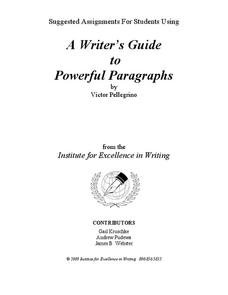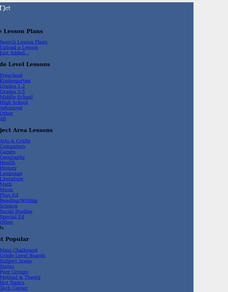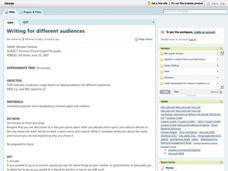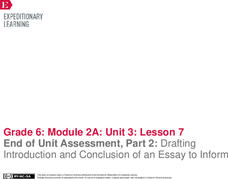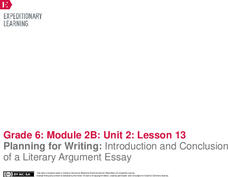Curated OER
Power Writing to Elaborate: Paragraph Writing, Main Idea
Students are walked through an outline (Power Writing) and shown how to elaborate on a main idea in their writing.
Curated OER
Writing a Story
A terrific and meaningful presentation on story writing awaits your class. This really is a good one! Young writers are led through a series of slides that do a terrific job of teaching story elements, but the slides also stimulate their...
EngageNY
The Painted Essay for Opinion Writing: The Introductory Paragraph
The answer is blowin' in the wind. Using the resource, scholars read and analyze a model essay about wind power. Next, they work in groups to write an introductory paragraph that expresses an opinion about the topic.
School District No. 43
Writing a Greek Myth
Ask your learners to dream up a myth set in modern day. These mythology writing prompts require individuals take on the role of an ancient Greek citizen who just woke up to a totally different world. Through this lens, class members...
Institute for Excellence in Writing
A Writer’s Guide to Powerful Paragraphs
When it comes to teaching writing, it helps to start small. A supplementary guide to A Writer's Guide to Powerful Paragraphs provides suggested activities to help writers craft a variety of paragraphs. Each assignment covers a specific...
Curated OER
Narrative Writing Lesson
Sixth graders experience the stages of process writing, work cooperatively, to critique and to incorporate software tools to enhance writing and problem solving skills.
Curated OER
Writing Effective Thesis Statements and Introductory Paragraphs for Research Papers
After reading on the topic of their paper, high schoolers work in pairs to assess how to write powerful, precise thesis statements. The introduction contains three statements: a universal statement, a bridge statement, and a thesis...
Nancy Fetzer's Literacy Connections
Expository Paragraph
Upper elementary and middle school writers learn how to craft an expository paragraph by following the six steps detailed in a 48-page instructional guide. Learners learn how to write six different types of informational paragraphs: to...
Curated OER
Persuasive Writing II
Help your young writers use logic in their persuasive writing. Discuss the characteristics of a persuasive paper, and have pupils work together to explore and solve a syllogism. They will write a short persuasive paper which includes a...
Curated OER
Convey Ideas in Writing
Use the platforms of the 2004 presidential candidates to bring persuasive writing to your class. Young voters identify the three issues most important to them in the election and research the issues and candidates' positions. They write...
Curated OER
Unlocking the Secrets of a Persuasive Essay
Full of tips about structure, audience, and evidence in a persuasive essay, this presentation would be a great way to start a writing unit in your class. One slide advises young writers to make up quotes and statistics in their essays....
William E.B. DuBois Elementary
Persuasive Writing Graphic Organizer
Take your pick of 16 graphic organizers, all designed for persuasive writing. Some provide space to prepare an entire essay or speech, while others provide space for brainstorming and organizing ideas before settling on concrete ideas...
Curated OER
Writing For Different Audiences
Evaluate the use of vocabulary in written paragraphs to make the determination of its appropriateness for a particular audience. As a class, seventh graders develop a fictional team and write three paragraphs to different audiences based...
EngageNY
Mid-Unit 2 Assessment: On-Demand Informational Writing
Lesson 7 focuses on building academic vocabulary and writing an explanatory letter with supported textual evidence. For the first five minutes of the instructional activity, the educator reminds the class of how to read and refer to the...
EngageNY
End of Unit Assessment, Part 2: Drafting Introduction and Conclusion of an Essay to Inform
A powerful introduction and conclusion can really pack a punch. Using the resource, scholars first read and discuss a model essay. Then, as part of the end of unit assessment, they draft the introductory and concluding paragraphs of...
EngageNY
Planning for Writing: Introduction and Conclusion of a Literary Argument Essay
Give a powerful introduction. Scholars analyze the introductory paragraph in the model essay "Are We Medieval?: Opportunities in the Middle Ages and Today." They discuss the key components the author includes and then walk through the...
Curated OER
Informative Essay Writing
High schoolers start by drawing Mr. Essay Man, who is supposed to illustrate the different parts of an essay. After discussing what each component should contain, writers start their essay, guided by the teacher and class discussion....
Curated OER
Effective Writing is More Than a Five Paragraph Essay
Groups become experts in one aspect of the six traits of writing, prepare a PowerPoint presentation, jigsaw, and teach others about their trait. Writers then focus on these traits as they compose a persuasive essay about a person they...
Curated OER
Intro to Essay Writing for High Schoolers
Emerging writers observe and demonstrate the process of writing an essay. As a class, they read and discuss the writing steps, read a sample essay, and write an outline for a three-paragraph essay. Then they write a final version of...
K12 Reader
Why Do We Need Pronouns?
Who needs pronouns? Everyone! Show your class the power of pronouns with this worksheet. Learners read a sample paragraph that doesn't include any pronouns and then revise that paragraph by filling in the appropriate pronouns.
EngageNY
Informative Paragraph Pre-Assessment: What Is One Reason You Want the Power of Reading?
This writing pre-assessment has minimal instruction but maximum support and encouragement. It begins with a review of the book, Rain School, through a think-pair-share and small group discussion. The discussion focuses on the idea that...
EngageNY
Reading Proficiently and Independently: The Power of Setting Goals
Scholars reflect upon their reading strengths and challenges to create personal reading goals. Participants use goal-setting verbiage in an accordion-style graphic organizer, a first step in writing a letter that details their reading...
Santa Ana Unified School District
The Power of Point of View
Sometimes a whole story can change based on the perspective of the person telling it. Practice identifying and analyzing point of view in various reading passages and writing assignments with a language arts packet, complete with Common...
Curated OER
Black Power
Use this New York Times lesson to research contemporary leaders in the African-American community. After reading the article "Blacks Weigh the Impact of the Post-Jackson Years," middle and high schoolers discuss the varying viewpoints of...






